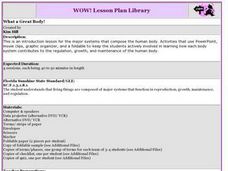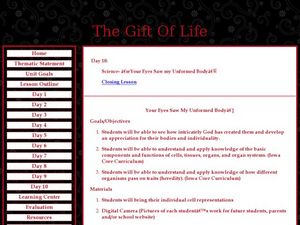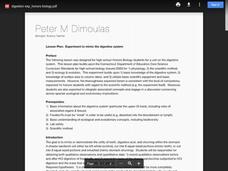Curated OER
The Digestive System
Sixth graders use the Internet to examine the human digestive system. Using a diagram, they identify and explain the functions of each organ involved in the digestion process. They complete an online activity as well to end the lesson.
Curated OER
Skeletal, Skin, and Muscular Systems
Eighth graders explain the functions of various body systems. Using a concept map, 8th graders identify and explain the fuctions of the skeletal, skin, and muscular systems of the body. After completing their concept map, students...
Curated OER
Systems Working Together
Fourth graders practice reading in the content areas (science) in order to explore the interdependence of the body systems. They answer written questions after reading.
Curated OER
It's My Body
Students research the human body. In this human body lesson, students brainstorm the connections between the parts of a bike and a human digestive system. Students work in small groups and research a specific body system. Students then...
Curated OER
Organs and What They Do - Lecture
Students read information about the internal organs and body systems. In this organs and systems lesson, students read descriptions of the heart, lungs, stomach, small and large intestine, and liver and gall bladder. Students study...
Curated OER
What a Great Body!
Students use PowerPoint, movie clips, graphic organizers, and a foldable to research and display information about how each body system contributes to the regulation, growth, and maintenance of the human body. Additional links and...
Curated OER
Levels of Organization
Middle schoolers read and complete a worksheet about the levels of organization of living things from cells to organ systems. They use a text book and the "Cells R Us" worksheet included to create a metaphor for each of the levels. ...
Curated OER
Diversity And Adaptations Of Organisms
Seventh graders demonstrate the processes of science by posing questions and investigating phenomena through language, methods and instruments of science. They study the body features or systems of several animals.
Curated OER
The Respiratory and Urinary System
For this body systems worksheet, students read information about the processes involved in the respiratory and urinary systems. Students then answer 1 short answer and 2 multiple choice questions.
Curated OER
Fayettewood Squares
If used as a center activity, this short presentation could be a motivating way for learners to review material relating to plants, the circulatory system, and more. However, there are only nine questions. It would be more useful if...
Tracy Pendry
Cardiovascular/Circulatory System
Explore the circulatory system with a cardiovascular pump activity that promotes discovery and discussion as class members create a functioning model of the heart. Continue the learning process through a web quest showcasing the...
Curated OER
Muscular and Skeletal Systems
How do muscles move bones? Find out using a built-in-class model. Pupils construct a hand model with paper and string, then follow a series of directions to explore the movement process. Discover additional information about the muscular...
Curated OER
Life Science: Human Body Skit
Learners create skits based on the human body systems. Working in groups, they role-play as organs in the various systems. They make costumes or wear signs identifying themselves as the organs in their skits.
Curated OER
Brain Awareness Week
Students explore human anatomy by completing a list of activities over five days. In this brain science lessons, students examine images of brains and identify the different parts. Students complete an in-class quiz regarding brain...
Curated OER
GED: Vocabulary: Life Science
In this GED vocabulary worksheet, students complete a crossword puzzle given 10 clues about genetics and cloning, food chains, vaccines, the brain and the nervous system and organisms. Students are given a word bank to use to complete...
Curated OER
Maintaining the Internal Environment
Explore homeostasis in animals with this all-encompassing learning exercise. Advanced biology pupils consider a variety of mechanisms for maintaining internal conditions such as temperature and waste products. Eighteen short-answer...
Curated OER
The Making of an Organ
Students examine and research how cells make up our organs. They create a model of a tongue showing cells, tissues and the organ.
Curated OER
Your Eyes Saw My Unformed Body: closing lesson
For those who teach and believe in Intelligent Design, this lesson is perfect. Religion learners read and discuss Psalm 139: 1-18, and present their cell representation in class. They then watch a speech by Louie Giglio about the protein...
Curated OER
Digestion and Nutrition
Debunk the theory that a soda-and-candy diet is a nutritionally sound concept! Learners first read 2 paragraphs of background information covering essential nutrients, digestion, and homeostasis. Then, they use the information they...
Curated OER
Human Body Parts
Learners create body cutouts of themselves and label specific internal and external organs/parts that are covered in class in this exciting lesson on Human Anatomy. Digital cameras and pictures of various internal organs are required.
Curated OER
A Body Dilemma
Students explore the pros and cons of the selling of body parts in this lesson. A discussion of how personal value systems impact science and research is developed.
Curated OER
Experiment to Mimic the Digestive System
Students demonstrate how digestion occurs. In this biology lesson, students compare the mass of sandwiches before and after addition of HCl. They collect data and formulate conclusion based on experimental results.
Curated OER
It's Time to Get Organ-Wised
Students engage in a lesson which contains several ideas for a unit on the body and body organs. They solve riddles, color in shapes of organs, participate in games and read about the functions of the various organs. Worksheets are...
Curated OER
The Human Organism
Students identify their feelings and learn constructive ways of handling conflict. In this human mental health lesson, students identify their feelings, learn how to tell others about their feelings, and learn how to resolve conflict....























